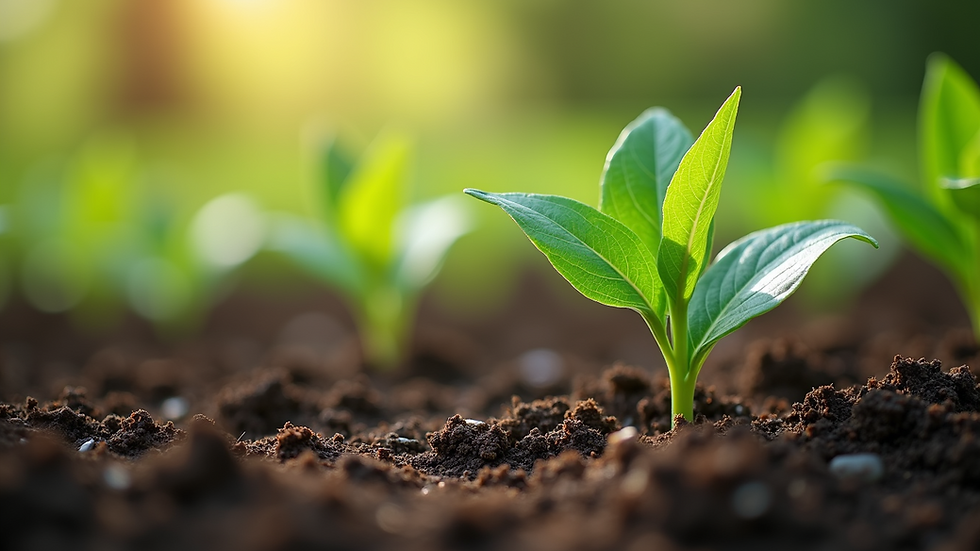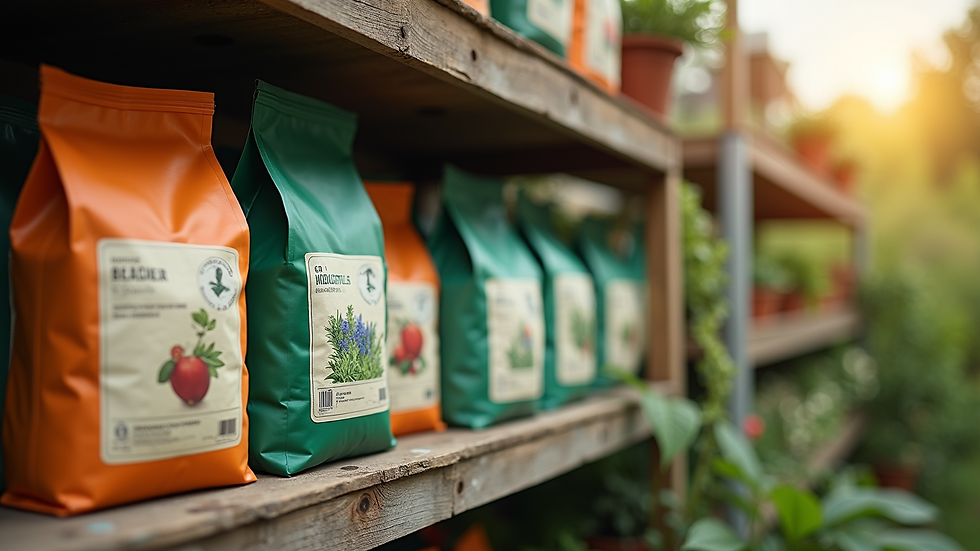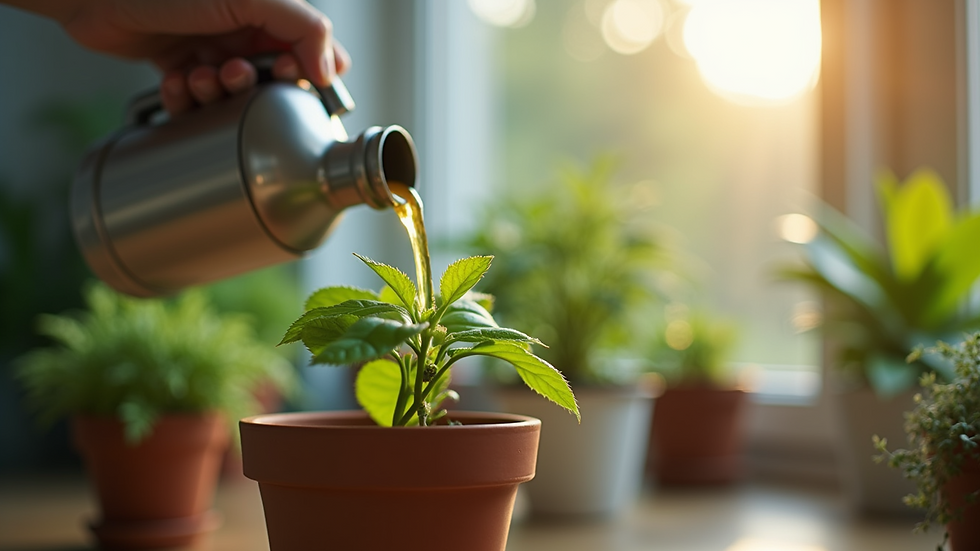How to Use Fertilizers for Healthy Plant Growth
- info035788
- Jul 31
- 4 min read
Fertilizers play a crucial role in helping plants grow strong and healthy. They provide essential nutrients that plants need to thrive, especially when the soil lacks these vital elements. Using the right plant fertilizer correctly can improve plant health, increase yields, and enhance the beauty of your garden or indoor plants. This guide will walk you through the basics of using fertilizers effectively to support your plants' growth.
Understanding Plant Fertilizer and Its Importance
Plant fertilizer is a substance that supplies essential nutrients to plants. These nutrients include macronutrients like nitrogen (N), phosphorus (P), and potassium (K), as well as micronutrients such as iron, magnesium, and zinc. Each nutrient has a specific role in plant development:
Nitrogen (N) promotes leafy growth and vibrant green color.
Phosphorus (P) supports root development and flower production.
Potassium (K) enhances overall plant health and disease resistance.
Fertilizers come in various forms, including granular, liquid, and slow-release types. Choosing the right fertilizer depends on the type of plants you are growing and the condition of your soil.
Regular fertilization helps replenish nutrients that plants absorb from the soil. Without adequate nutrients, plants may show signs of deficiency such as yellowing leaves, stunted growth, or poor flowering. Using fertilizer correctly ensures your plants get the nourishment they need to flourish.

How to Choose the Right Plant Fertilizer
Selecting the appropriate plant fertilizer is essential for healthy growth. Here are some tips to help you make the right choice:
Test Your Soil
Before applying fertilizer, test your soil to determine its nutrient content and pH level. This will help you identify which nutrients are lacking and avoid over-fertilizing.
Understand Plant Needs
Different plants have different nutrient requirements. For example, leafy vegetables need more nitrogen, while flowering plants benefit from higher phosphorus levels.
Select Fertilizer Type
Granular fertilizers are easy to apply and provide nutrients over time.
Liquid fertilizers offer quick nutrient absorption and are ideal for foliar feeding.
Slow-release fertilizers gradually supply nutrients, reducing the risk of burning plants.
Check the N-P-K Ratio
Fertilizers are labeled with three numbers representing nitrogen, phosphorus, and potassium content. Choose a ratio that matches your plant’s growth stage and type.
Consider Organic vs. Synthetic
Organic fertilizers improve soil health and release nutrients slowly, while synthetic fertilizers provide immediate nutrient availability.
By understanding these factors, you can select a fertilizer that best supports your plants’ growth and health.

Is all-purpose plant food good for all plants?
Many gardeners wonder if all purpose plant food is suitable for every type of plant. The answer depends on the specific needs of your plants and the soil conditions.
All-purpose plant food is designed to provide a balanced mix of nutrients that support a wide range of plants. It typically contains a moderate ratio of nitrogen, phosphorus, and potassium, making it versatile for general use. This type of fertilizer is convenient for gardeners who grow a variety of plants and want a simple solution.
However, some plants have specialized nutrient requirements. For example:
Acid-loving plants like azaleas and blueberries prefer fertilizers formulated for acidic soil.
Succulents and cacti need fertilizers with lower nitrogen content to prevent excessive leafy growth.
Heavy feeders like tomatoes and corn benefit from fertilizers with higher nitrogen levels.
Using all-purpose plant food can be effective for many plants, but it may not provide optimal results for plants with unique needs. It’s important to observe your plants and adjust fertilization accordingly. If you notice signs of nutrient deficiency or poor growth, consider switching to a fertilizer tailored to your specific plants.

How to Apply Fertilizer Correctly for Best Results
Applying fertilizer properly is just as important as choosing the right type. Here are some practical steps to ensure your plants get the most benefit:
Follow Package Instructions
Always read and follow the manufacturer’s guidelines for application rates and frequency. Over-fertilizing can harm plants and the environment.
Apply at the Right Time
Fertilize during the active growing season when plants can absorb nutrients efficiently. Avoid fertilizing dormant plants.
Use the Correct Method
Granular fertilizers should be spread evenly around the base of the plant and lightly worked into the soil.
Liquid fertilizers can be applied directly to the soil or sprayed on leaves for quick absorption.
Slow-release fertilizers are mixed into the soil at planting or applied on the surface.
Water After Fertilizing
Watering helps dissolve fertilizer and carry nutrients to the roots. Avoid applying fertilizer to dry soil without watering.
Avoid Fertilizer Burn
Applying too much fertilizer or applying it too close to plant stems can cause leaf burn or root damage. Maintain a safe distance from stems and use recommended amounts.
Consider Foliar Feeding
For quick nutrient boosts, spray diluted liquid fertilizer on leaves. This method is especially useful for correcting micronutrient deficiencies.
By following these steps, you can maximize the effectiveness of your fertilizer and promote healthy plant growth.
Tips for Maintaining Healthy Plants Beyond Fertilization
Fertilizer is just one part of plant care. To keep your plants thriving, consider these additional tips:
Water Properly
Consistent watering supports nutrient uptake and prevents stress. Avoid overwatering, which can wash away nutrients.
Mulch Around Plants
Mulching helps retain soil moisture, regulate temperature, and reduce weed competition.
Prune Regularly
Removing dead or diseased parts encourages new growth and improves air circulation.
Monitor for Pests and Diseases
Healthy plants are less susceptible to pests. Early detection and treatment prevent damage.
Rotate Crops in Gardens
Changing plant locations each season helps prevent nutrient depletion and soil-borne diseases.
Use Compost and Organic Matter
Adding compost improves soil structure and nutrient content naturally.
Combining these practices with proper fertilization creates an ideal environment for your plants to grow strong and healthy.

Encouraging Growth with the Right Fertilizer Strategy
Using fertilizer effectively is a key step toward achieving lush, productive plants. Remember to:
Test your soil to understand nutrient needs.
Choose fertilizers that match your plants’ requirements.
Apply fertilizer carefully and at the right time.
Combine fertilization with good watering, mulching, and pruning habits.
By adopting a thoughtful fertilizer strategy, you can enjoy vibrant flowers, abundant vegetables, and healthy indoor plants. Whether you are a beginner or an experienced gardener, these tips will help you make the most of your plant fertilizer and support your plants’ growth throughout the seasons.



Comments